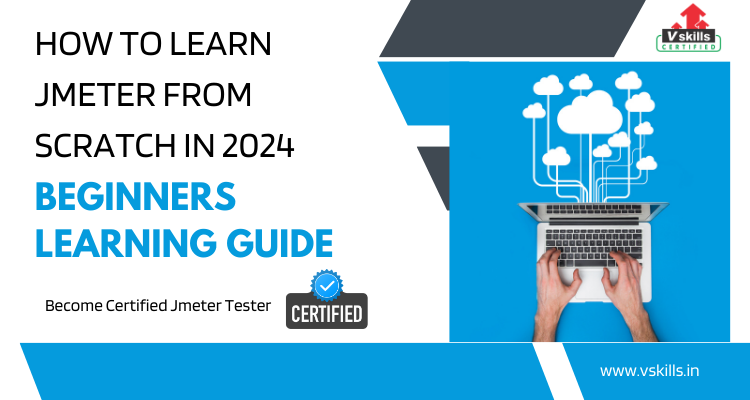The digital world thrives on smooth performance. Websites and applications need to be fast, reliable, and able to handle even the most demanding workloads. That’s where JMeter comes in – a robust, open-source tool that empowers you to test and analyze the performance of your software like a pro. It is therefore important to learn Jmeter in a proper manner with a proper learning platform that makes you job-ready.
Whether you’re a beginner or just starting your performance testing journey, this guide is your passport to mastering JMeter in 2024. By the end of this guide, you’ll be confident in using JMeter to identify performance bottlenecks, optimize your software, and deliver exceptional experiences for your users. So, buckle up and get ready to embark on your JMeter learning adventure!
How many days will it take to learn JMeter?
The time it takes to learn JMeter truly depends on your individual learning pace, prior experience, and desired level of mastery. Here’s a breakdown to help you estimate:
Basic JMeter usage:
- Grasping core concepts and running simple tests: 1-3 days of focused learning can equip you with the basics of JMeter components, creating simple tests, and interpreting results.
- Building moderate-complexity tests: To craft tests with advanced samplers, assertions, and parameterization, expect to dedicate 1-2 weeks of consistent practice and exploration.
Advanced JMeter skills:
- Mastering performance optimization techniques, integrations, and best practices: Dedicating 2-3 months to in-depth learning, experimentation, and real-world projects can elevate you to an advanced JMeter user.
Remember, these are just rough estimates. Some individuals might grasp concepts faster, while others prefer a slower, more thorough approach. The key is to find a learning pace that suits you and stay consistent in your practice.
Is it easy to learn JMeter? So, here are some factors that can influence your learning time:
- Prior experience: Familiarity with web technologies, scripting languages, and performance testing concepts can accelerate your JMeter journey.
- Learning resources: The quality and variety of resources you choose, such as tutorials, courses, or documentation, can impact your learning speed.
- Practice and experimentation: Hands-on practice with building and analyzing tests is crucial for solidifying your understanding and developing mastery.
Don’t focus solely on the number of days. Instead, embrace the learning process, celebrate your progress, and enjoy the satisfaction of gaining valuable skills that can enhance your career and benefit your projects.
What are the prerequisites to learn JMeter?
The prerequisites for learning JMeter vary depending on your desired level of proficiency and prior experience. Here’s a breakdown to help you assess your readiness:
Essential Requirements:
- Basic computer literacy: Familiarity with operating systems, file management, and internet browsing is crucial for navigating the installation and basic operation of JMeter.
- Understanding of web technologies: Knowing how websites work, including HTTP protocols, HTML, and basic web server architecture, can significantly enhance your comprehension of JMeter functionalities.
- Analytical thinking: JMeter involves analyzing test results, identifying performance bottlenecks, and interpreting data. Strong analytical skills will be crucial for effectively utilizing the tool.
Recommended prerequisites:
- Scripting language knowledge: While not mandatory, familiarity with scripting languages like Python or Java can unlock advanced JMeter features like custom samplers and data manipulation.
- Performance testing fundamentals: Some basic understanding of performance testing concepts, such as load testing, stress testing, and performance metrics, can provide a helpful foundation for using JMeter effectively.
- Experience with testing tools: Prior experience with other testing tools, particularly web application testing tools, can ease the transition to JMeter’s interface and concepts.
Remember:
- You don’t need to master everything before starting: Focus on the essential requirements and gradually build your knowledge as you learn and practice with JMeter.
- Numerous resources are available: Don’t hesitate to leverage online tutorials, courses, and documentation to overcome any knowledge gaps or challenges you encounter.
- Community support is readily available: The JMeter community is vibrant and supportive. Many forums, discussions, and Q&A platforms exist to assist you with your learning journey.
Basic JMeter Concepts
Before diving into test creation, let’s equip you with the essential JMeter tools:
1. What is JMeter?
- Purpose: JMeter is a free and open-source software designed for performance testing. It simulates real-world user traffic to measure how your application handles various workloads.
- Capabilities: It can test websites, web services, APIs, databases, and more, revealing potential bottlenecks and areas for optimization.
2. Key Components:
- Threads: These virtual users simulate actual users interacting with your application. You can adjust the number of threads to replicate different traffic scenarios.
- Thread Groups: Organize threads into logical units to manage different test scenarios or user groups.
- Samplers: The heart of JMeter tests, they represent specific actions users take, like sending HTTP requests, executing database queries, or running scripts.
- Listeners: Collect and display test results in various formats, such as graphs, tables, or logs, for analysis and interpretation.
- Assertions: Set expectations for test responses, allowing you to validate that your application behaves as intended and identify any unexpected behaviors.
JMeter Learning Guide
Want to make websites and apps lightning-fast? JMeter’s your superhero! This beginner-friendly guide will equip you with the basics to test your software like a pro!
Why Learn JMeter?
● Make websites fly: Identify slowdowns and fix them before users get frustrated.
● Boost user happiness: Smoother performance means happy users coming back for more.
● Land cool jobs: JMeter skills are in high demand!
Ready to get started?
1. Download JMeter for free: It’s like installing a game, but way more awesome!
2. Meet the JMeter crew: Threads, samplers, listeners! These are the tools you’ll use to build your tests.
3. Send your virtual spies: Tell them what to check, like which website pages and how many users to pretend to be.
4. See the results: JMeter gives you reports like graphs and charts, showing you where things are fast or slow.
5. Fix the slowdowns: Use the data to make your website a champion of speed!
Bonus Tips:
● Practice makes perfect: Build simple tests first and gradually level up.
● Online resources are your friends: Jmeter Tutorials, blogs, and forums are there to help you.
● Don’t be afraid to ask: The JMeter community is super friendly and supportive.
Remember, mastering JMeter takes time and effort, but the rewards are totally worth it! So, buckle up, unleash your inner performance tester, and watch your websites zoom to the top!
JMeter Courses: Your Options for Mastering Performance Testing
Here’s a rundown of available JMeter certification courses. Popular Online Courses:
Vskills JMeter Certified Tester:
- Format: Online self-paced learning with video lectures, practice exercises, and a final exam.
- Content: On point! Covers core JMeter concepts, test planning and execution, performance analysis, assertions, and best practices.
- Benefits: Affordable, government-verified certification, lifetime access to course materials, and dedicated support.
Choosing the Right Course:
- Your Skill Level: Consider your existing knowledge of JMeter and performance testing to choose a suitable course difficulty.
- Learning Style: Some courses emphasize video lectures, while others focus on hands-on activities. Select a format that aligns with your learning preferences.
- Budget: Pricing varies depending on the platform and course features. Compare options before making a decision.
- Certification Preference: If certification is important, look for courses aligned with recognized JMeter certifications.
Additional Resources:
- The Apache JMeter Project: Official website with comprehensive documentation, tutorials, and community forums.
- PerfBytes Blog: Features insightful articles and tutorials on performance testing and JMeter.
- LoadView Community: A platform for performance testing discussions and knowledge sharing.
Ultimately, the best JMeter certification course depends on your individual needs and learning goals. Explore your options, compare features, and choose the one that aligns best with your journey to mastering performance testing!
How to perform load testing using JMeter?
Here’s a comprehensive guide on performing load testing using JMeter:
1. Plan Your Test:
- Define objectives: Clearly articulate what you aim to measure (e.g., response times, throughput, error rates).
- Identify target URLs: Specify the web pages or services you’ll test.
- Determine user load: Decide the number of concurrent virtual users to simulate.
- Set performance criteria: Establish acceptable response times and throughput thresholds.
2. Create a Test Plan:
- Launch JMeter: Open the application and initiate a new test plan.
- Add Thread Group: Insert a Thread Group element, setting the number of threads (virtual users) and ramp-up time (how quickly they start).
- Incorporate Samplers: Add relevant samplers based on your test’s focus (e.g., HTTP Request sampler for web pages).
- Configure Samplers: Set URLs, request methods, parameters, and headers for each sampler.
3. Add Listeners:
- Attach Listeners: Include listeners to visualize and analyze results (e.g., Graph Results, Aggregate Report).
4. Set Assertions:
- Incorporate Assertions: Add assertions to validate responses and identify unexpected behaviors (e.g., Response Assertion, Duration Assertion).
5. Run the Test:
- Start the Test: Click the “Run” button to execute the test.
- Monitor Results: Observe test progress and results in real-time using listeners.
6. Analyze Results:
- Review Performance Metrics: Examine response times, throughput, error rates, and other relevant metrics.
- Identify Bottlenecks: Pinpoint areas of performance degradation.
- Generate Reports: Create comprehensive test reports for documentation and sharing.
Additional Tips:
- Parameterize Tests: Use variables to make tests reusable and adaptable.
- Utilize Timers: Simulate realistic user actions with pauses and delays.
- Consider Plugins: Expand JMeter’s capabilities with plugins for database testing, security testing, and more.
- Optimize Performance: Tune JMeter settings and test scripts for efficient execution.
- Follow Best Practices: Adhere to recommended guidelines for accurate and reliable results.
Remember:
- Gradual Load Increase: Start with a small load and gradually increase it to avoid overwhelming your system.
- Monitor Resources: Keep an eye on server resources (CPU, memory, network) during testing.
- Replicate Real-World Scenarios: Design tests that mimic actual user behavior and traffic patterns.
- Iterate and Improve: Use test results to optimize your application and testing approach.
JMeter Real-time Examples
Here are some illustrative real-world examples of JMeter in action:
1. E-commerce Website Stress Testing:
- Scenario: Simulate a Black Friday sale with thousands of concurrent users browsing products, adding items to carts, and checking out.
- Goal: Ensure the website can handle peak traffic without crashing or slowing down, preventing lost sales and frustrated customers.
2. API Performance Evaluation:
- Scenario: Test a new banking API’s ability to process thousands of transactions per second, ensuring reliability and speed for critical financial services.
- Goal: Identify any bottlenecks or latency issues that could impact user experience and service availability.
3. Mobile App Load Testing:
- Scenario: Simulate a large-scale app launch with thousands of users downloading and using the app simultaneously.
- Goal: Verify the app’s ability to scale and handle high demand, preventing crashes, slow response times, and negative user reviews.
4. Streaming Media Performance Testing:
- Scenario: Simulate thousands of users watching live video streams or on-demand content to ensure smooth playback and seamless delivery.
- Goal: Identify any buffering issues, lag, or video quality degradation that could impact user engagement and satisfaction.
5. Database Load Testing:
- Scenario: Evaluate a database’s ability to handle heavy query loads, ensuring optimal response times and preventing data access delays.
- Goal: Optimize database performance, query tuning, and resource allocation for efficient data management.
Additional Examples:
- Web application load testing: Evaluating website response times under various user loads.
- API load testing: Assessing API performance and scalability under stress.
- Security testing: Conducting security-focused tests to identify vulnerabilities.
- Mobile app testing: Testing mobile app performance on different devices and networks.
- IoT testing: Simulating device interactions and data flows in IoT systems.
Each of these examples highlights JMeter’s versatility in addressing various performance testing needs across diverse industries and application types.
JMeter Best Practices
Mastering JMeter involves not just understanding its features, but also applying best practices for accurate and efficient testing. Here are some key tips to elevate your performance testing game:
1. Planning and Design:
- Define clear objectives: Know what you’re testing and what metrics matter (e.g., response times, throughput, errors).
- Realistic user scenarios: Mimic actual user behavior patterns and traffic loads.
- Modular test scripts: Break down tests into reusable components for easier maintenance.
2. Efficient Test Execution:
- Ramp-up users gradually: Simulate realistic user arrival patterns, avoiding sudden load spikes.
- Parameterization: Use variables to inject dynamic data and avoid repetitive test scripts.
- Correlation: Extract dynamic values from responses to reuse in subsequent requests.
3. Data Analysis and Reporting:
- Choose relevant listeners: Analyze results with appropriate visualization tools (e.g., graphs, tables).
- Set performance thresholds: Establish acceptable metrics and identify bottlenecks.
- Generate comprehensive reports: Document test results and findings for clear communication.
4. Optimization and Performance:
- Monitor server resources: Track CPU, memory, and network usage during testing.
- Tune JMeter settings: Optimize thread groups, heap size, and other JMeter settings for efficiency.
- Cleanup unnecessary listeners: Disable unnecessary listeners during execution to optimize resource usage.
5. Community and Resources:
- Utilize the JMeter community: Leverage forums, blogs, and discussions for support and knowledge sharing.
- Stay updated with JMeter versions: Upgrade to the latest version for improved features and bug fixes.
- Practice and experiment: Continuously learn and explore new functionalities and best practices.
Remember, mastering JMeter is a journey, not a destination. By incorporating these best practices into your workflow, you’ll be well on your way to conducting reliable, efficient, and insightful performance tests, ensuring your applications are always in top shape!
Expert Corner
You’ve embarked on a thrilling journey into JMeter, the ultimate weapon for conquering performance bottlenecks and ensuring stellar user experiences. This exploration has equipped you with foundational knowledge, real-world examples, and invaluable best practices to navigate your testing endeavors with confidence.
The road to JMeter mastery is paved with continuous learning and experimentation. Dive deeper into advanced features, refine your test design skills, and actively engage with the vibrant JMeter community. Every challenge overcome, every optimization achieved, will propel you closer to becoming a performance-testing champion. So, keep practicing, exploring, and pushing your knowledge’s boundaries. The world of JMeter awaits, and with your dedication, it’s yours to conquer!



